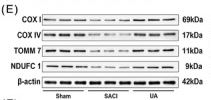NDUFC1 Antibody - #DF9667
| Product: | NDUFC1 Antibody |
| Catalog: | DF9667 |
| Description: | Rabbit polyclonal antibody to NDUFC1 |
| Application: | WB IHC IF/ICC |
| Cited expt.: | WB |
| Reactivity: | Human, Mouse, Rat |
| Prediction: | Pig, Bovine, Horse, Rabbit |
| Mol.Wt.: | 9kDa; 9kD(Calculated). |
| Uniprot: | O43677 |
| RRID: | AB_2842863 |
Related Downloads
Protocols
Product Info
*The optimal dilutions should be determined by the end user. For optimal experimental results, antibody reuse is not recommended.
*Tips:
WB: For western blot detection of denatured protein samples. IHC: For immunohistochemical detection of paraffin sections (IHC-p) or frozen sections (IHC-f) of tissue samples. IF/ICC: For immunofluorescence detection of cell samples. ELISA(peptide): For ELISA detection of antigenic peptide.
Cite Format: Affinity Biosciences Cat# DF9667, RRID:AB_2842863.
Fold/Unfold
CI-KFYI; Complex I KFYI subunit; Complex I-KFYI; KFYI; mitochondrial; NADH dehydrogenase (ubiquinone) 1, subcomplex unknown, 1, 6kDa; NADH dehydrogenase [ubiquinone] 1 subunit C1; NADH dehydrogenase [ubiquinone] 1 subunit C1, mitochondrial; NADH-ubiquinone oxidoreductase KFYI subunit; NDUC1_HUMAN; NDUFC1;
Immunogens
A synthesized peptide derived from human NDUFC1, corresponding to a region within C-terminal amino acids.
- O43677 NDUC1_HUMAN:
- Protein BLAST With
- NCBI/
- ExPASy/
- Uniprot
MAPSALLRPLSRLLAPARLPSGPSVRSKFYVREPPNAKPDWLKVGFTLGTTVFLWIYLIKQHNEDILEYKRRNGLE
Predictions
Score>80(red) has high confidence and is suggested to be used for WB detection. *The prediction model is mainly based on the alignment of immunogen sequences, the results are for reference only, not as the basis of quality assurance.
High(score>80) Medium(80>score>50) Low(score<50) No confidence
Research Backgrounds
Accessory subunit of the mitochondrial membrane respiratory chain NADH dehydrogenase (Complex I), that is believed not to be involved in catalysis. Complex I functions in the transfer of electrons from NADH to the respiratory chain. The immediate electron acceptor for the enzyme is believed to be ubiquinone.
Mitochondrion inner membrane>Single-pass membrane protein>Matrix side.
Belongs to the complex I NDUFC1 subunit family.
Research Fields
· Human Diseases > Endocrine and metabolic diseases > Non-alcoholic fatty liver disease (NAFLD).
· Human Diseases > Neurodegenerative diseases > Alzheimer's disease.
· Human Diseases > Neurodegenerative diseases > Parkinson's disease.
· Human Diseases > Neurodegenerative diseases > Huntington's disease.
· Metabolism > Energy metabolism > Oxidative phosphorylation.
· Metabolism > Global and overview maps > Metabolic pathways.
· Organismal Systems > Nervous system > Retrograde endocannabinoid signaling. (View pathway)
References
Application: WB Species: Mouse Sample: cardiac tissues
Restrictive clause
Affinity Biosciences tests all products strictly. Citations are provided as a resource for additional applications that have not been validated by Affinity Biosciences. Please choose the appropriate format for each application and consult Materials and Methods sections for additional details about the use of any product in these publications.
For Research Use Only.
Not for use in diagnostic or therapeutic procedures. Not for resale. Not for distribution without written consent. Affinity Biosciences will not be held responsible for patent infringement or other violations that may occur with the use of our products. Affinity Biosciences, Affinity Biosciences Logo and all other trademarks are the property of Affinity Biosciences LTD.







